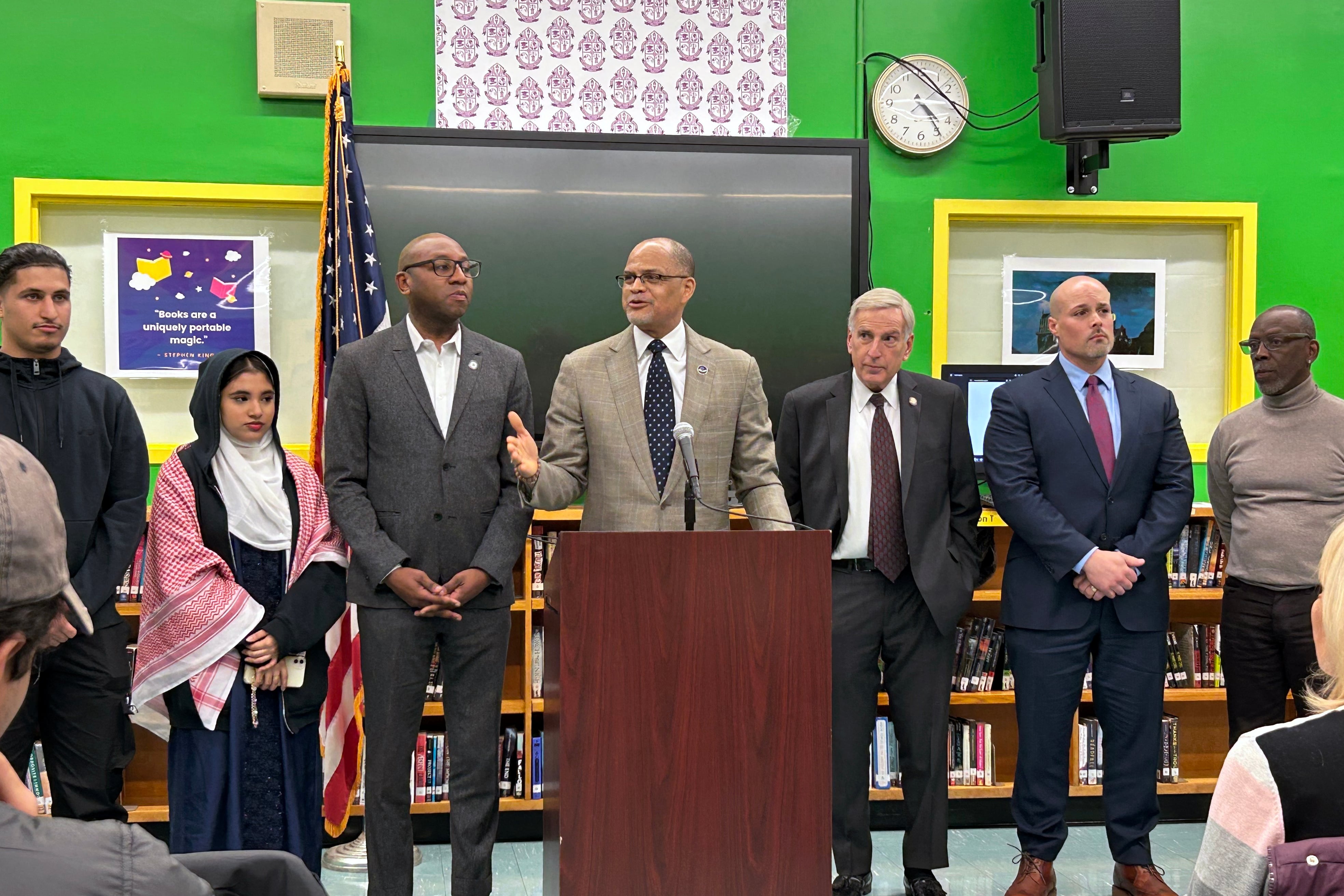New York City schools Chancellor David Banks vowed Monday that last week’s chaotic student rally for the ouster of a pro-Israel teacher at Hillcrest High School can be a “teachable moment.”
The turmoil unfolded on Nov. 20 when hundreds of students filled the halls of the Queens school in protest of a social media photo of a teacher holding an “I Stand With Israel” sign, according to students and officials. Social media videos show a raucous gathering with students dancing in hallways and a water fountain ripped from the wall. The health teacher at the center of the protest, who is Jewish, took cover in an administrator’s office on a separate floor, officials said.
Multiple students were disciplined for their role in organizing the protest, but officials declined to provide details because of privacy restrictions.
The incident drew a wave of condemnations over the Thanksgiving break, including a statement from Mayor Eric Adams calling it a “vile show of anti-semitism.”
During a visit to the school Monday, Banks, an alum of Hillcrest, tried to strike a balance between denouncing students’ actions and pushing back on what he described as overly broad criticism of the students.
“A teacher … was targeted based on her support for Israel, expressed in a permissible way outside of school hours, and her Jewish identity, and that is completely unacceptable,” Banks said Monday.
He added, in reference to media coverage of the incident and statements from some elected officials, that “the notion … these kids are radicalized and antisemitic is the height of irresponsibility, and I for one will not accept that at all.”
Students used social media to organize the walkout, which started during a changeover between classes, officials said. An estimated 400 students participated in the initial protest out of Hillcrest’s roughly 2,300-person student body. A followup student protest was planned for Nov. 22, but administrators were able to shut it down before it started, officials said.
School officials said they got wind of the Nov. 20 protest in time to alert police, who responded quickly. The teacher targeted in the protest, whose name Chalkbeat is withholding to protect her privacy, was already in an administrator’s office on another floor talking with police when the protest began, and she stayed there throughout, officials said.
Banks maintained the teacher was “never in direct danger.”
The educator didn’t reply to a request for comment, but previously told the New York Post that she was “shaken to my core by the calls to violence against me that occurred online and outside my classroom last week.”
Several students and elected officials also reported students threatened the teacher and posted her address online.
Banks said the teacher is expected to return to work this week and promised that the school will “ensure her safety” and that staff and students will “wrap arms around” her.
The school is partnering with an organization called Operation Respect to help lead conversations about improving school culture, officials said.
Students at Hillcrest acknowledged Monday that the protest had gotten out of hand, but maintained that the students who escalated the action weren’t the ones who’d organized it.
“It was meant to be a peaceful protest in the very beginning,” said Muhammad Ghazali, the senior class president. “But some of these students lack maturity. These are teenagers.”
Many of the students who participated didn’t “think of it as a serious moment or a moment to actually go out and protest,” but “did it for their personal enjoyment,” he added.
Another student who spoke to Chalkbeat anonymously pushed back on the accusation that the protest was antisemitic.
“The intent … was just to be pro-Palestine,” the student said. “It was not, it was not to attack her for being Jewish. We have teachers that are Jewish, and we love them to death.”
Banks said he came to Hillcrest Monday not just to offer a condemnation but to listen to students and try to better understand what sparked their anger.
Roughly 30% of Hillcrest’s students are Muslim, and some “came from warzones” like Yemen, said one Hillcrest educator who spoke on the condition of anonymity. What’s happening in Gaza is “traumatic” for them, the educator added.
“They consume their information through social media,” Banks said. “And what they are seeing on a daily basis are children and young people in Palestine … being blown up.”
“When they all of a sudden saw this image of the teacher that says, ‘I Stand With Israel,’ the students articulated to me they took that as a message that I’m affirming whatever is happening to the Palestinian family and community,” Banks said. “That made sense to me.”
Schools across New York City have struggled with how — and if — to talk to students about Hamas’ Oct. 7 attack on Israel, in which militants killed an estimated 1,200 Israelis and took more than 200 hostage, and Israel’s subsequent bombardment, which has killed more than 14,000 people, according to Palestinian health authorities.
Students told Chalkbeat they’re inundated with graphic images of the violence on social media and often struggle to make sense of conflicting sources of information. Many crave safe spaces to talk about those issues in school.
But many educators are wary of wading into such a potentially explosive conversation — some more so after Banks reminded teachers not to share their political beliefs in class and cautioned about out-of-school political activism.
Several Hillcrest students said they had few chances to talk about what is happening in Gaza and Israel before last week’s events.
“Don’t just think you can just skate by it,” one student said. “Because these [issues] are in these children’s hearts, and they’re going to feel a type of way about it. So it’s best to address it … It’s a boiling pot. Now, that exploded, and this is what happened.”
Michael Elsen-Rooney is a reporter for Chalkbeat New York, covering NYC public schools. Contact Michael at melsen-rooney@chalkbeat.org.






